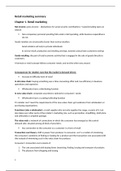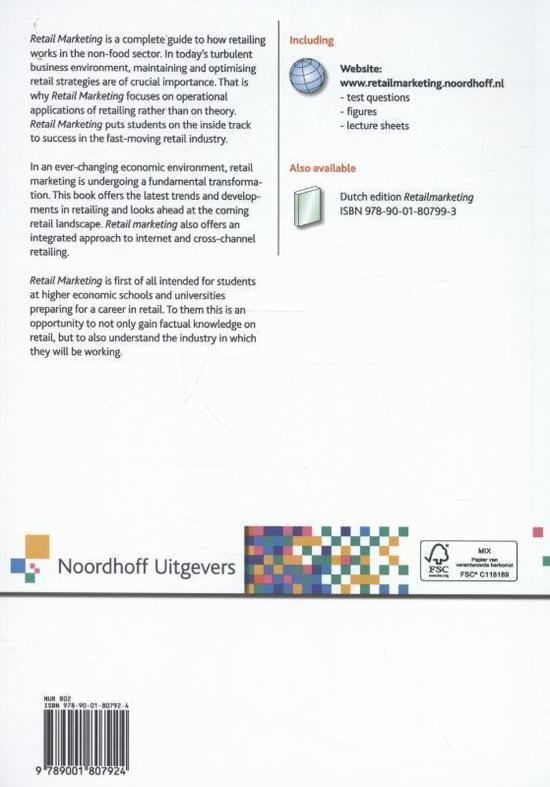Retail marketing summary
Chapter 1. Retail marketing
Net income: gross income – (deductions for social security contributions + taxes(including taxes on
salary))
Non-compulsory personal spending falls under retail spending, while business expenditures
do not.
Goods-retailers are structurally clearer than service-retailers:
Good-retailers sell only to private individuals
In service-retail: production and retailing overlaps, business and private customers overlap
Goods-retailing: the part of total economic activity that is engaged in the sale of goods directly to
customers.
A formula or retail concept follows consumer needs, and not the other way around.
Consequences for retailers now that the market is demand-driven:
Increase in difficulty level of retail
In old value chain: buying something was a time-consuming affair and, low efficiency in business
operations and expensive.
Wholesalers have a distributing function
In new value chain: composite assortment, tailored to consumers’ needs
Wholesalers have a curating/collecting function
If a retailer can’t meet the requirements of the new value chain: get assistance from wholesalers or
purchasing organisations.
Franchisor (also a wholesaler): a retail supplier who not only supplies the range, or parts of it, but
also takes over other parts of the retailer’s marketing mix, such as promotion, shopfitting, shelf plans
and ultimately a complete package.
The value web: a network of connections in which the consumer has emerged as the central
demand side, situated among all kinds of providers.
Any connection to the consumer as a customer is a form of retail
Transaction cost theory: shift in power from producer to consumer, so it’s a matter of minimising
the consumer’s problems of finding or looking for a product and the transaction cost associated with
this instead of minimising cost in the value chain for producer.
Consumer’s transaction cost consists of:
1. The cost associated with buying items (searching, finding, buying and transport of products
2. The pleasure from shopping and buying
1
,The consumer will choose the supplier where the balance of costs and revenues is most favourable.
Transaction-cost matrix:
Analysis based on transaction-cost matrix:
1. Bricks and mortar retail in certain sectors, lose market share to internet retailers
a. What will you do? Choose between keep doing what you’re doing and pressure on
revenue OR gaining market share by investing in new channel, but this will put
pressure on profitability
2. Pure players’ sale is growing but not all are able to make sales profitable. The reason for this
is:
Marketing costs: due to unfamiliarity of the consumer with new products, this results in
high marketing costs, high break-even point.
a. Winner-takes-all principle: because of name recognition and trust
b. Backlog in trust has decreased: because of labels that indicate reliability and
reviews.
c. Conversion for online retailers is lower than for bricks-and-mortar retailers.
However, not fair, because of the visitor numbers that are different.
Fulfillment costs
a. Artificial Intelligence could help handle return flows --> meet consumer demand.
b. Online players are facing shorter cut-off times --> because of next day delivery,
online players need a larger stock.
c. Virtual stock: offers advantages in speed and short turnaround times, lower
inventory and logistics costs
d. One stock principle: all stock in the central warehouse and in the bricks-and-mortar
retail shops is seen as a single inventory.
----------------------------------------------------------------------------------------------------------------------------------
Chapter 2. The retailing of goods in the Netherlands: classification criteria
E-tail sales: goods retailers go through the online channel
The growth in the online retail sector remains well ahead of the growth in the total retail.
The sector that shows the most significant growth in online spending is food, followed by
health & beauty, shoes and telecom.
2
,Webrooming: browsing takes place online, following by buying offline (in store)
Showrooming: browsing offline and buying online
Classification by form of legal cooperation
Buying associations initially worked on a voluntary basis: they were allowed to buy via the
association but were not obliged to do so. Independent, affiliated companies often also presented
themselves to the consumers under their own name.
The buying associations have disappeared, have developed into independent retail organisations or
retail service organizations, or have joined larger retail groups. In the non-food sector, the buying
associations have developed into retail service organisations --> Franchising takes over
Franchising is also referred to as a growth strategy.
The franchisor is able to expand the chain with a relatively smaller capital requirement
The span of control is greater than what is possible with a cooperative chain
Important for development in terms of sales
Important for employment
Important in adjacent sector: food service, aka hospitality retail
Hard franchising
Conversion franchising: stores run directly by the business are converted into
franchise locations
Chain often offers a store manager the opportunity to become an
independent entrepreneur
Can help to increase market share
The lower cost level enables the entrepreneur to achieve higher returns
Soft franchising:
Movements in the market seem to lead to an increasing number of soft-franchise
organisations switching to hard franchising.
Advantages franchisee:
Join a reputable formula at a relatively low cost
Don’t have to divide attention among the many focus areas associated with the retail
business
They can remain independent
Concentrate fully on managing shop and personnel and leave other activities (buying,
promotion, shop concept)
Advantages franchisor:
Direct return on the fee paid by franchisee
Formula can expand more quickly with less of an investment on their part
3
, o This leads to faster coverage of catchment area --> can make external promotion
process more efficient in terms of cost per contact
o It leads to an increase in buying volume --> improvement in buying conditions (lower
purchase price or in terms of the ability to develop one’s own store brands)
Classification by operation
Logistics-oriented retail trade
Often retail businesses that involve product categories with a stable range of products over
time
Procurement process: focus on availability (ensuring that the product range is always there) than
on innovation (ensuring constant innovation)
Sales process: focus on ensuring the optimal presence and findability of items on the shelves
Daily sales activities are focused on that the internal logistics run well
Daily activities consist of agreeing on longer-term conditions and ensuring that the external
logistics is in order.
Marketing focuses on the presence of a range of products the consumer knows.
Sales-oriented retail trade
Often retail businesses that have to cope with categories of products that are bought
relatively frequently, wholly or partly unstable product ranges, and consumer purchasing
behavior that goes with a limited orientation.
Sale-ability is central to the buying process
Buying is prepared to make concessions to the product-range philosophy if they can trade
with it, or attract additional customers
The buying culture is item-oriented (instead of to the product range)
Pressure to advertise is extremely high --> use aggressive sales techniques
Sales process: focus on a succession of action-oriented approaches and a great deal of
attention to outside advertising
Buying-oriented retail trade
Buying process: focus on predicting and estimating fashion trends and on developments in
customer behavior
o Buying function is becoming a sourcing function
o Marketing is their responsibility; marketing is aimed at building recognisable retail
formula, based on offering and not just items but a total concept
Sales process: focuses on making clear to the target group the product-range philosophy on
the shop floor; sales mix aim is to attract customers
Concerns around operational characteristics:
4






